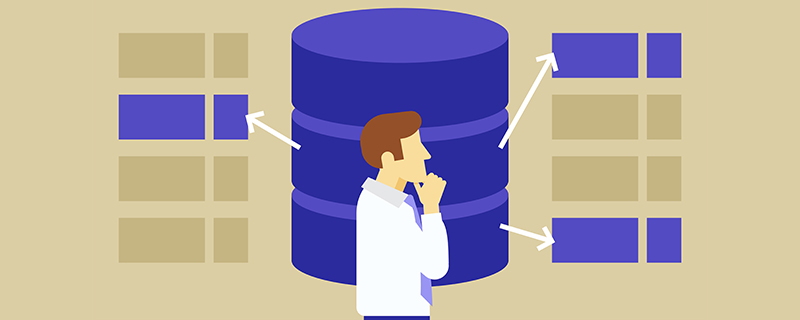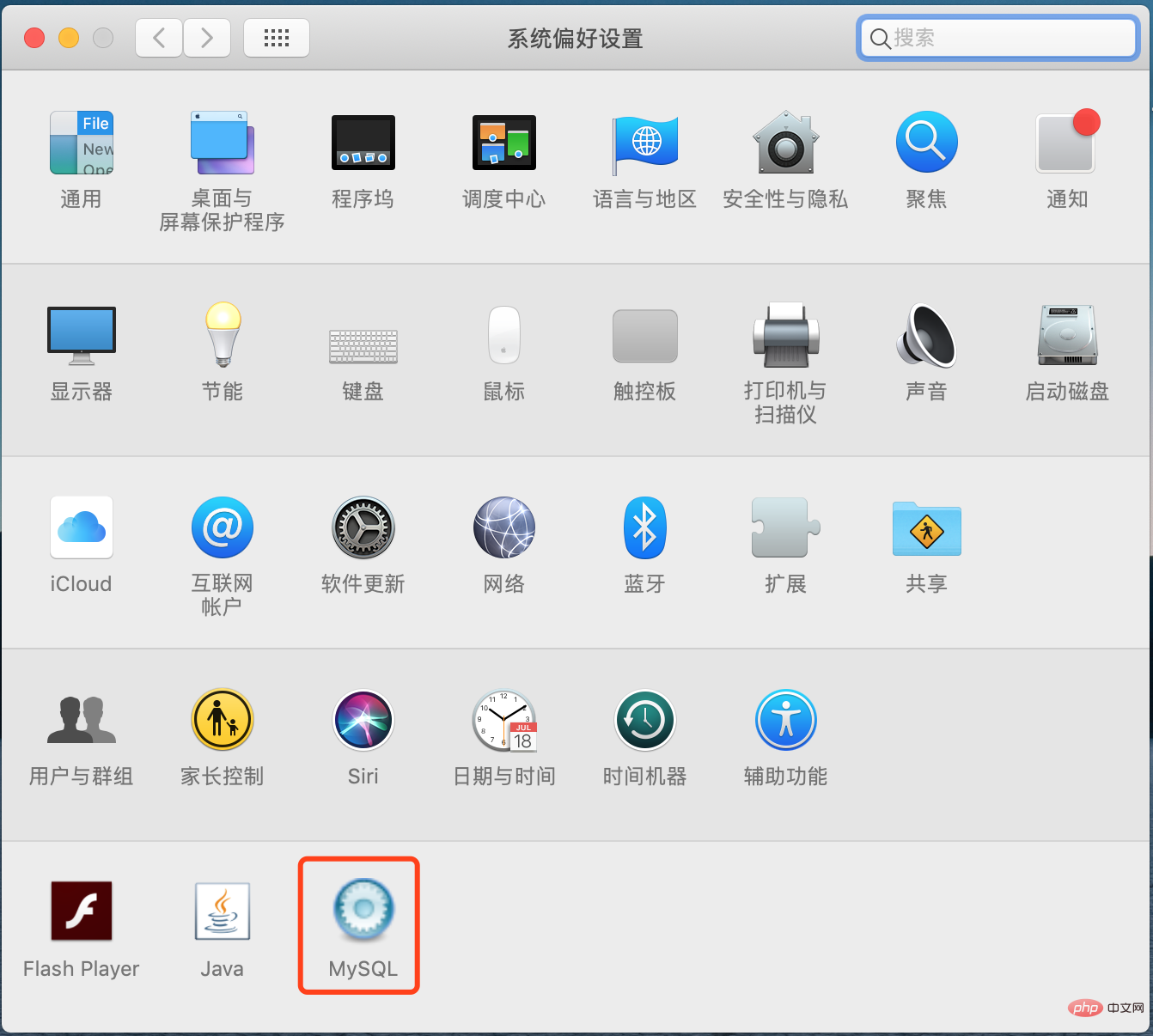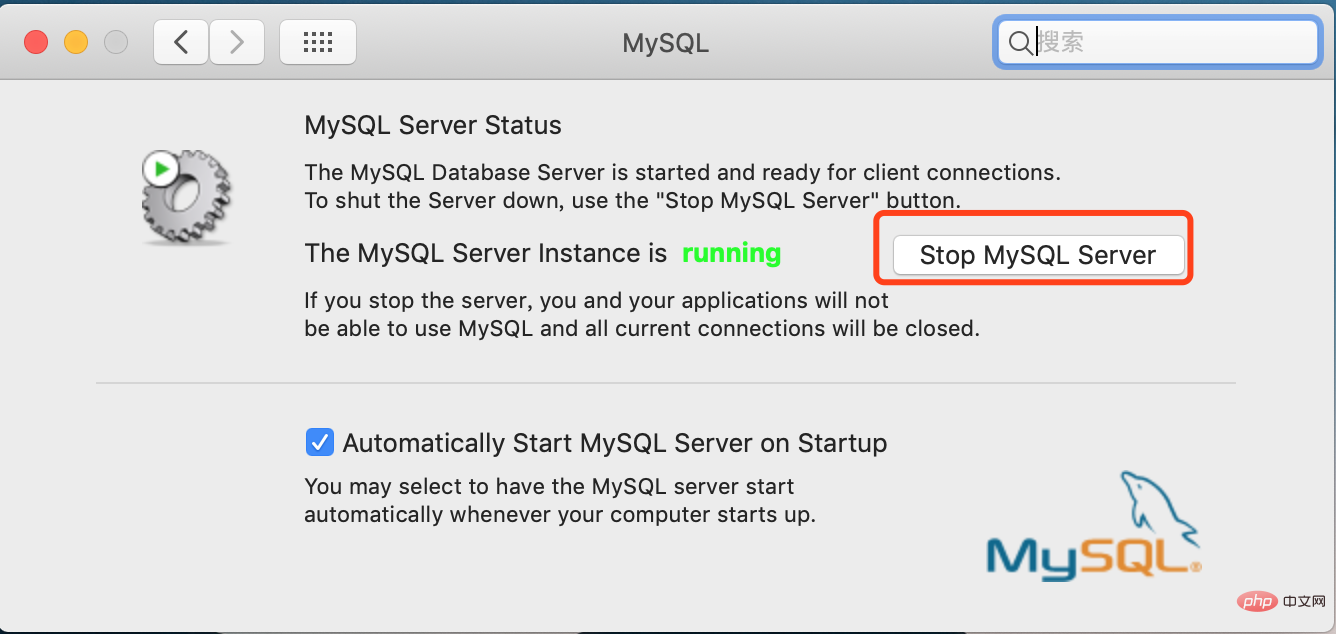Mac mysql이 깨졌을 경우 어떻게 해야 하나요?
mac mysql 잘못된 코드에 대한 해결 방법: 1. my.cnf 파일을 찾아서 엽니다. 2. 코드를 "character-set-server=utf8 init_connect='SET NAMES utf8..."으로 추가합니다.

이 기사의 운영 환경: macOS10.15 시스템, Mysql 버전 5.7.26, macbook pro 2020 컴퓨터.
mac mysql이 깨졌을 경우 어떻게 해야 하나요?
mac에서 MySQL의 문자 깨짐 문제를 해결하는 방법
이 문서에서는 Mac에서의 처리 방법에 대해 설명합니다. 내 컴퓨터의 mysql 버전은 5.7.26-log입니다.
인터넷의 많은 게시물에는 /usr/local/mysql/support-files 디렉터리로 이동하여 my-default.cnf를 /etc/my.cnf에 복사하라고 나와 있습니다. 그러면 Linux에서의 수정 방법과 같습니다. Mac 버전의 MySQL은 5.7.18 이후 my-default.cnf가 취소되었기 때문에 my-default.cnf와 my.cnf를 사용할 수 없습니다. my-default.cnf는 이전 버전에만 있던 파일입니다.
안타깝게도 mysql 버전이 5.7.18 이후라면 새 버전을 만드세요
cd /etc sudo vim my.cnf
다음 코드를 my.cnf
# Example MySQL config file for medium systems. # # This is for a system with little memory (32M - 64M) where MySQL plays # an important part, or systems up to 128M where MySQL is used together with # other programs (such as a web server) # # MySQL programs look for option files in a set of # locations which depend on the deployment platform. # You can copy this option file to one of those # locations. For information about these locations, see: # http://dev.mysql.com/doc/mysql/en/option-files.html # # In this file, you can use all long options that a program supports. # If you want to know which options a program supports, run the program # with the "--help" option. # The following options will be passed to all MySQL clients [client] default-character-set=utf8 #password = your_password port = 3306 socket = /tmp/mysql.sock # Here follows entries for some specific programs # The MySQL server [mysqld] character-set-server=utf8 init_connect='SET NAMES utf8 port = 3306 socket = /tmp/mysql.sock skip-external-locking key_buffer_size = 16M max_allowed_packet = 1M table_open_cache = 64 sort_buffer_size = 512K net_buffer_length = 8K read_buffer_size = 256K read_rnd_buffer_size = 512K myisam_sort_buffer_size = 8M character-set-server=utf8 init_connect='SET NAMES utf8' # Don't listen on a TCP/IP port at all. This can be a security enhancement, # if all processes that need to connect to mysqld run on the same host. # All interaction with mysqld must be made via Unix sockets or named pipes. # Note that using this option without enabling named pipes on Windows # (via the "enable-named-pipe" option) will render mysqld useless! # #skip-networking # Replication Master Server (default) # binary logging is required for replication log-bin=mysql-bin # binary logging format - mixed recommended binlog_format=mixed # required unique id between 1 and 2^32 - 1 # defaults to 1 if master-host is not set # but will not function as a master if omitted server-id = 1 # Replication Slave (comment out master section to use this) # # To configure this host as a replication slave, you can choose between # two methods : # # 1) Use the CHANGE MASTER TO command (fully described in our manual) - # the syntax is: # # CHANGE MASTER TO MASTER_HOST=<host>, MASTER_PORT=<port>, # MASTER_USER=<user>, MASTER_PASSWORD=<password> ; # # where you replace <host>, <user>, <password> by quoted strings and # <port> by the master's port number (3306 by default). # # Example: # # CHANGE MASTER TO MASTER_HOST='125.564.12.1', MASTER_PORT=3306, # MASTER_USER='joe', MASTER_PASSWORD='secret'; # # OR # # 2) Set the variables below. However, in case you choose this method, then # start replication for the first time (even unsuccessfully, for example # if you mistyped the password in master-password and the slave fails to # connect), the slave will create a master.info file, and any later # change in this file to the variables' values below will be ignored and # overridden by the content of the master.info file, unless you shutdown # the slave server, delete master.info and restart the slaver server. # For that reason, you may want to leave the lines below untouched # (commented) and instead use CHANGE MASTER TO (see above) # # required unique id between 2 and 2^32 - 1 # (and different from the master) # defaults to 2 if master-host is set # but will not function as a slave if omitted #server-id = 2 # # The replication master for this slave - required #master-host = <hostname> # # The username the slave will use for authentication when connecting # to the master - required #master-user = <username> # # The password the slave will authenticate with when connecting to # the master - required #master-password = <password> # # The port the master is listening on. # optional - defaults to 3306 #master-port = <port> # # binary logging - not required for slaves, but recommended #log-bin=mysql-bin # Uncomment the following if you are using InnoDB tables #innodb_data_home_dir = /usr/local/mysql/data #innodb_data_file_path = ibdata1:10M:autoextend #innodb_log_group_home_dir = /usr/local/mysql/data # You can set .._buffer_pool_size up to 50 - 80 % # of RAM but beware of setting memory usage too high #innodb_buffer_pool_size = 16M #innodb_additional_mem_pool_size = 2M # Set .._log_file_size to 25 % of buffer pool size #innodb_log_file_size = 5M #innodb_log_buffer_size = 8M #innodb_flush_log_at_trx_commit = 1 #innodb_lock_wait_timeout = 50 [mysqldump] quick max_allowed_packet = 16M [mysql] no-auto-rehash # Remove the next comment character if you are not familiar with SQL #safe-updates default-character-set=utf8 [myisamchk] key_buffer_size = 20M sort_buffer_size = 20M read_buffer = 2M write_buffer = 2M [mysqlhotcopy] interactive-timeout
마지막 단계는 mysql 서비스를 다시 시작하는 것입니다


추천 학습: "mysql 비디오 튜토리얼"
위 내용은 Mac mysql이 깨졌을 경우 어떻게 해야 하나요?의 상세 내용입니다. 자세한 내용은 PHP 중국어 웹사이트의 기타 관련 기사를 참조하세요!

핫 AI 도구

Undresser.AI Undress
사실적인 누드 사진을 만들기 위한 AI 기반 앱

AI Clothes Remover
사진에서 옷을 제거하는 온라인 AI 도구입니다.

Undress AI Tool
무료로 이미지를 벗다

Clothoff.io
AI 옷 제거제

AI Hentai Generator
AI Hentai를 무료로 생성하십시오.

인기 기사

뜨거운 도구

메모장++7.3.1
사용하기 쉬운 무료 코드 편집기

SublimeText3 중국어 버전
중국어 버전, 사용하기 매우 쉽습니다.

스튜디오 13.0.1 보내기
강력한 PHP 통합 개발 환경

드림위버 CS6
시각적 웹 개발 도구

SublimeText3 Mac 버전
신 수준의 코드 편집 소프트웨어(SublimeText3)

뜨거운 주제
 7425
7425
 15
15
 1359
1359
 52
52
 76
76
 11
11
 27
27
 19
19
 PHP가 MySQL에 연결된 후 페이지가 비어 있습니다. 유효하지 않은 다이 () 함수의 이유는 무엇입니까?
Apr 01, 2025 pm 03:03 PM
PHP가 MySQL에 연결된 후 페이지가 비어 있습니다. 유효하지 않은 다이 () 함수의 이유는 무엇입니까?
Apr 01, 2025 pm 03:03 PM
PHP가 MySQL에 연결 한 후 페이지가 비어 있고 Die () 함수가 실패한 이유가 있습니다. PHP와 MySQL 데이터베이스 간의 연결을 배울 때는 종종 혼란스러운 것들이 발생합니다 ...
 MySQL 데이터베이스에 대한 PHP PDO 연결 : Charset = UTF8 설정이 데이터베이스 문자 세트에 어떤 영향을 미칩니 까?
Apr 01, 2025 am 11:39 AM
MySQL 데이터베이스에 대한 PHP PDO 연결 : Charset = UTF8 설정이 데이터베이스 문자 세트에 어떤 영향을 미칩니 까?
Apr 01, 2025 am 11:39 AM
PHP ...
 램프 아키텍처에서 Node.js 또는 Python 서비스를 효율적으로 통합하는 방법은 무엇입니까?
Apr 01, 2025 pm 02:48 PM
램프 아키텍처에서 Node.js 또는 Python 서비스를 효율적으로 통합하는 방법은 무엇입니까?
Apr 01, 2025 pm 02:48 PM
많은 웹 사이트 개발자는 램프 아키텍처에서 Node.js 또는 Python 서비스를 통합하는 문제에 직면 해 있습니다. 기존 램프 (Linux Apache MySQL PHP) 아키텍처 웹 사이트 요구 사항 ...
 PC 및 모바일 측면에서 동일한 페이지를 공유하고 캐시 문제를 처리하는 방법은 무엇입니까?
Apr 01, 2025 pm 01:57 PM
PC 및 모바일 측면에서 동일한 페이지를 공유하고 캐시 문제를 처리하는 방법은 무엇입니까?
Apr 01, 2025 pm 01:57 PM
PC 및 모바일 측면에서 동일한 페이지를 공유하고 캐시 문제를 처리하는 방법은 무엇입니까? Baota 배경, PC 측면을 만드는 방법 및 ...
 데비안 문자열은 여러 브라우저와 호환됩니다
Apr 02, 2025 am 08:30 AM
데비안 문자열은 여러 브라우저와 호환됩니다
Apr 02, 2025 am 08:30 AM
"Debiantrings"는 표준 용어가 아니며 구체적인 의미는 여전히 불분명합니다. 이 기사는 브라우저 호환성에 직접 언급 할 수 없습니다. 그러나 "Debiantrings"가 Debian 시스템에서 실행되는 웹 응용 프로그램을 지칭하는 경우 브라우저 호환성은 응용 프로그램 자체의 기술 아키텍처에 따라 다릅니다. 대부분의 최신 웹 응용 프로그램은 크로스 브라우저 호환성에 전념합니다. 이는 웹 표준에 따라 웹 표준과 잘 호환 가능한 프론트 엔드 기술 (예 : HTML, CSS, JavaScript) 및 백엔드 기술 (PHP, Python, Node.js 등)을 사용하는 데 의존합니다. 응용 프로그램이 여러 브라우저와 호환되도록 개발자는 종종 브라우저 크로스 테스트를 수행하고 응답 성을 사용해야합니다.
 Docker는 LNMP 환경을 구축합니다. 단일 Dockerfile 또는 Docker가 더 나은가?
Apr 01, 2025 pm 02:09 PM
Docker는 LNMP 환경을 구축합니다. 단일 Dockerfile 또는 Docker가 더 나은가?
Apr 01, 2025 pm 02:09 PM
Dockerfile LNMP 환경 학습을위한 Dockerfile 모범 사례 Docker 동안 많은 개발자가 자체 LNMP (Linux, Nginx, MySQL, PHP)를 구축하려고합니다.
 Redis 대기열과 MySQL 안정성 비교 : Redis가 데이터 손실에 발생하는 이유는 무엇입니까?
Apr 01, 2025 pm 02:24 PM
Redis 대기열과 MySQL 안정성 비교 : Redis가 데이터 손실에 발생하는 이유는 무엇입니까?
Apr 01, 2025 pm 02:24 PM
Redis 대기열과 MySQL 안정성 비교 : Redis가 데이터 손실에 발생하는 이유는 무엇입니까? PHP7.2 및 ThinkPHP 프레임 워크를 사용하여 개발 환경에서 우리는 종종 협력의 선택에 직면 해 있습니다 ...
 Django와 MySQL을 사용하여 수십만에서 2 백만에서 2 백만 건의 데이터를 처리 할 때, 4 코어 8G 메모리 서버는 어떤 종류의 캐시 솔루션을 선택해야합니까?
Apr 01, 2025 pm 11:36 PM
Django와 MySQL을 사용하여 수십만에서 2 백만에서 2 백만 건의 데이터를 처리 할 때, 4 코어 8G 메모리 서버는 어떤 종류의 캐시 솔루션을 선택해야합니까?
Apr 01, 2025 pm 11:36 PM
Django 및 MySQL을 사용하여 Django 및 MySQL 데이터베이스를 사용할 때 큰 데이터 볼륨을 처리합니다. 데이터 볼륨이 수십만에서 2 백만에 도달하면 ...




